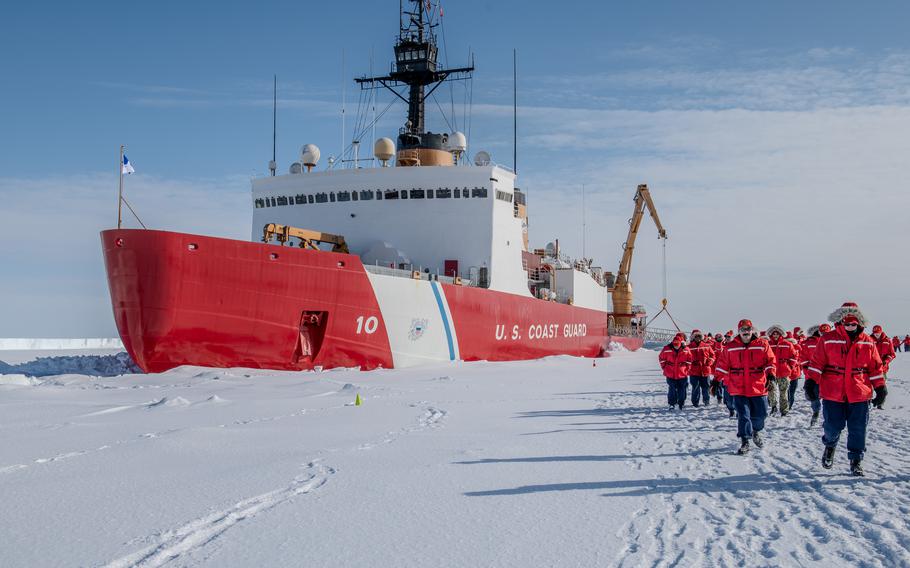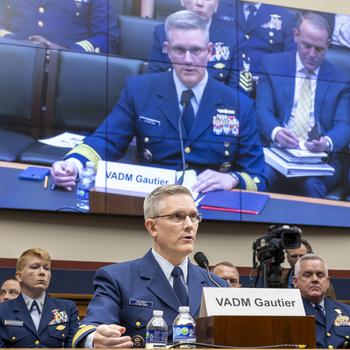
The Coast Guard is attempting to boost its presence in the Arctic but a lack of assets, particularly icebreaker ships that can navigate through ice-covered waters, has put the U.S. at a significant disadvantage against the growing joint operations of Russia and China, a Coast Guard official told House lawmakers on Thursday, Nov. 14, 2024. (Ryan Graves/U.S. Coast Guard)
WASHINGTON — Russia and China have for the first time started conducting joint operations in the Arctic, dramatically stepping up their activity in a part of the world where the U.S. and Russia share a maritime boundary, a Coast Guard commander said Thursday.
Vice Adm. Peter Gautier, deputy commandant for operations, told lawmakers that the Coast Guard recently witnessed the Russian Border Guard and Chinese Coast Guard conducting a joint patrol high in the Bering Sea in a worrying sign of growing collaboration.
“That’s a first that just tells us that their Arctic cooperation is only expanding,” Gautier said in testimony to a House Transportation and Infrastructure Committee panel overseeing the Coast Guard and maritime transportation.

Vice Adm. Peter Gautier, deputy commandant for operations for the Coast Guard, makes remarks Thursday, Nov. 14, 2024, at a House hearing in Washington about the Arctic region. (Eric Kayne/Stars and Stripes)
Last month, the Coast Guard said it spotted four Russian and Chinese vessels moving 440 miles southwest of St. Lawrence Island, a part of Alaska. The two Chinese vessels were seen at the “northernmost” point that the Coast Guard had ever observed Chinese ships.
China has declared itself a “near-Arctic state.” But it is Russia, with one-fifth of its landmass north of the Arctic Circle, that has aggressively moved to militarize the Arctic and stake a claim to shipping routes and energy reserves expected to open as climate change melts the region’s ice.
China is increasingly joining those efforts as the countries deepen a partnership aimed at challenging the geopolitical dominance of the United States. In July, Chinese and Russian long-range bombers patrolled together near Alaska for the first time, prompting the U.S. and Canada to scramble their fighter jets in a show of defense.
Gautier said the Coast Guard is attempting to boost its own presence in the Arctic, but a lack of assets, particularly icebreaker ships that can navigate through ice-covered waters, has put the U.S. at a significant disadvantage.
The U.S. has just two operational icebreakers: the medium icebreaker USCGC Healy and the heavy icebreaker USCGC Polar Star, which is long past its service life. A second heavy icebreaker, USCGC Polar Sea, has been out of service since 2010 due to engine failure.
The American fleet pales in comparison to that of Russia and China. Russia operates 55 icebreakers, including 18 military icebreakers, and China has two medium and two heavy icebreakers and plans to build more.
“America, the greatest country on the face of the Earth, is — let’s call it what it is — behind. We’re behind,” said Rep. Jefferson Van Drew, R-N.J. “We’re behind Russia, and we’re going to be behind China, maybe we are already.”
The Coast Guard is struggling to close the gap.
A nearly $12 billion program to acquire three heavy icebreakers, with the first delivery scheduled for this year, has fallen behind schedule and is now not expected to produce an icebreaker until 2031.
Lawmakers on Thursday blamed the delays on a U.S. shipbuilding industry that has not built a heavy icebreaker in nearly 50 years. But they also chastised the Coast Guard for failing to approve a final design for the vessel and not raising the alarm about insufficient funding.
“This is tiresome,” said Rep. John Garamendi, D-Calif. “We’ve gone round and round on this for more than a decade, and we still are looking at another half a decade, at best, to get a heavy icebreaker.”
“The fact of the matter is, we will not have a presence in the Arctic,” he added.

“This is tiresome,” said Rep. John Garamendi, D-Calif. “We’ve gone round and round on this for more than a decade, and we still are looking at another half a decade, at best, to get a heavy icebreaker.” (Eric Kayne/Stars and Stripes)
Vice Adm. Thomas Allan, the Coast Guard’s deputy commandant for mission support, said the service is on track to notify Congress by the end of the year that it is beginning production on the first of the heavy icebreakers.
A 2023 internal fleet analysis showed the Coast Guard will need eight or nine icebreaker ships, including four to five heavy icebreakers and four to five medium icebreakers, to perform its polar missions in the coming years.
Gautier on Thursday said the service now needs the ships “as soon as possible.”
“We are at risk without recapitalizing these icebreakers,” he said. “We have a national security threat now from the increased presence of competitors and [the competitors] working together in ways that we have not seen yet.”